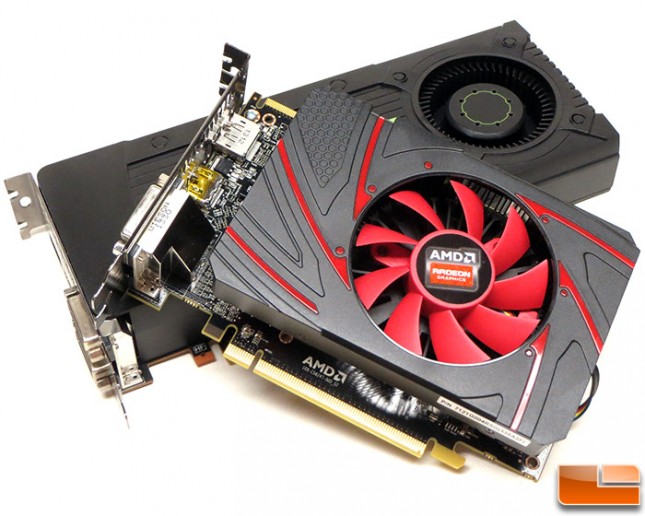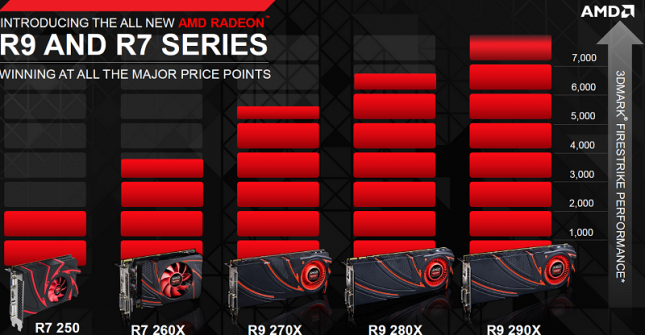AMD Radeon R7 260X Versus NVIDIA GeForce GTX 650 Ti Boost Video Card Review
Final Thoughts and Conclusions
The AMD Radeon R7 260X graphics card is affordable at $139, but we quickly discovered that it faces tough competition against the NVIDIA GeForce GTX 650 Ti Boost. In our benchmark the NVIDIA GeForce GTX 650 TI BOOST 2GB was clearly faster across the board at both 1920×1080 and 2560×1600 screen resolutions. That said, the AMD Radeon R7 260X video card is surprisingly powerful and was able to play pretty much every game we threw at it on a 1080P panel. We found that you can’t blindly crank up all the image quality settings with the Radeon R7 260X, but if you are okay with medium image quality settings in most ‘Tier 1’ game titles, you would be okay with this card. The AMD R7 series is supposed to be about causal gamers that want to be able to run DirectX 11.2 and OpenGL 4.3 game titles and this card can certainly do that.

While the AMD Radeon R7 260X didn’t beat the NVIDIA GEForce GTX 650 Ti BOOST in our performance testing, it was able to run cooler, quieter and use less power at both idle and load. Is this enough to make up for the slower gaming performance? Most gamers would likely say not a chance as they’d take performance over a bit of noise or heat as long as it is within reason. You are the one that needs to answer that, but you have all the data here in this review to come up with your conclusions.
Overclocking performance on the AMD Radeon R7 260X didn’t disappoint as we were able to overclock the core from 1100MHz to 1225MHz with ease. This is inline with what we have seen on the AMD Radeon HD 7790, which uses the same exact Bonaire XT GPU. The 2GB of GDDR5 memory by SKHynix overclocked all the way up to 7200MHz effective, which was very impressive and higher than we’ve ever taken any Radeon HD 7790 in the past!

The one thing we wish we knew about the AMD Radeon R7 260X and the performance of the card is how it will perform with Mantle. Once some game titles come out that are optimized for Mantel, like Battlefield 4, will that make up for the performance gaps that we saw between these two competing cards? The same can be said about AMD TrueAudio as programmable audio is sure to be amazing, but we won’t be able to try it out until 2014. Unusable features on a video card make it tough to review and will likely make your purchasing decision tougher as well.
The AMD Radeon HD R7 260X wasn’t able to beat the NVIDIA GeForce GTX 650 TI BOOST when it comes to gaming performance right now, but we don’t know what AMD Mantle will bring to the table when the Battlefield 4 patch comes out in December. Will we see the AMD Radeon R7 260X performing better than the NVIDIA GeForce GTX 650 TI BOOST in that game title? How many more Mantle supporting game titles will be coming out? The same goes for AMD TrueAudio. How many games will be supporting AMD TrueAudio in 2014? Right now the list we have been shown only shows 3-4 game titles. AMD will need more than a few game titles to come out with support for both to help sway buyers at certain price points like this one at $139. We aren’t sure how this will play out just yet.
At the end of the day the AMD Radeon R7 260X is a re-brand of the AMD Radeon HD 7790 that came out in March 2013. The performance is a bit behind the NVIDIA GeForce GTX 650 Ti BOOST 2GB, but it is quieter, cooler and more efficient. It also brings new technologies to the table and that we like that. AMD TrueAudio and the Mantle API look good on paper, so we can’t wait to see how successful they are. The AMD Radeon R7 260X might not have won the battle today, but the innovative features make it an interesting card. If you want AMD TrueAudio it is either this card or having to jump up to the AMD Radeon R9 290 for hundreds of dollars more.

Legit Bottom Line: The AMD Radeon R7 260X isn’t faster than the NVIDIA GeForce GTX 650 Ti BOOST 2GB, but it wins in some areas and contains unproven features that could change things down the road.
